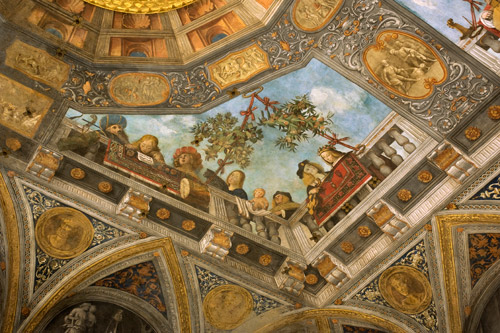.jpg)
Even though it bears the name of Ludovico Maria Sforza, called Il Moro, duke of Milan from 1494-1499, the Palazzo was actually commissioned by Antonio Costabili, an important nobleman of the court of duke Ercole I d'Este, secretary and Ambassador for the Este in Milan. The building was projected by Biagio Rossetti , the most distinguished ferrarese architect of the Renaissance, to whom the duke Ercole in 1492 entrusted the grand plan of urbanistic reorganization of the city, the so called "Herculean Addition“. The realisation of the project involved many prominent stonemasons and painters, but the building remained unfinished. A complex restoration to the structure, its decoration, and the gardens, completed in 2010, had the purpose of bringing back its original splendor, and making it completely accessible to the public.
The palace rose on the ancient Via della Ghiara (Gravel street, today Via XX Settembre), named for the gravel deposited by an ancient branch of the river Po that used to flow here.The construction of the building, according to local historians, was suggested by Ludovico il Moro himself, who wanted to have a safe exile, in case he was to lose his duchy. It is also a testimony of historical and political alliances between the two cities, Ferrara and Milano, already strengthened by matrimonial bonds-Lodovico was married with Beatrice, the daughter of Ercole I, and was the uncle of Anna Sforza, married with Alfonso d'Este.
Central point of the palace is the Courtyard of Honour, completed only on two sides and adorned with a double lodge with sculptural decorations in white stone. This work was probably executed by Gabriele Frisoni, to whom the marble monumental staircase that leads the visitor to the noble floor is also attributed.
.jpg)
A pictorial jewel of the Renaissance period is the Treasure Room, frescoed in 1506 by Benvenuto Tisi, called Garofalo.

At the end of the 16th century, when the Costabili family extinguished, the palace passed through a series of owners and divisions, which caused a progressive decline of the structure. In 1920 the State acquired it for 195.000 liras, from the families Giovannini and Antinori, last owners of the estate. This was done under the initiative of Corrado Ricci,, general director of the Ministry of Antiquities and Fine Arts, in the moment when the conditions of the building were outermost reduced: "Il Palazzone" (its most popular denomination) had reached its most squalid condition, until the Ministry of National Education in 1929 decided to arrange it as the displaying seat for the archaeological materials discovered at the Etruscan necropolis of Spina. The works accomplished from 1932 had the purpose to turn the Palazzo into a Museum and give it back its dignity through restoration and consolidation interventions. According to the theories of that time, this implied stylistic remakes and the elimination of most parts of the baroque decorations.
From the 90's of last century the Ministry of Cultural Heritage and Activities, along with the Municipality of Ferrara, provided interventions of technological adaptation of the facilities and of philological restoration- of the architectonic complex and its pictorial decorations, and of the garden- which took on the situation of deterioration and brought back the original beauty and importance of the Palazzo.
In Palazzo Costabili the result was most admirable than it was expected, so much so no one can find the Burchkardt’s praise overstated:
"This courtyard is worth ten palaces, even though unfinished and feeble." Salvatore Aurigemma 1936.